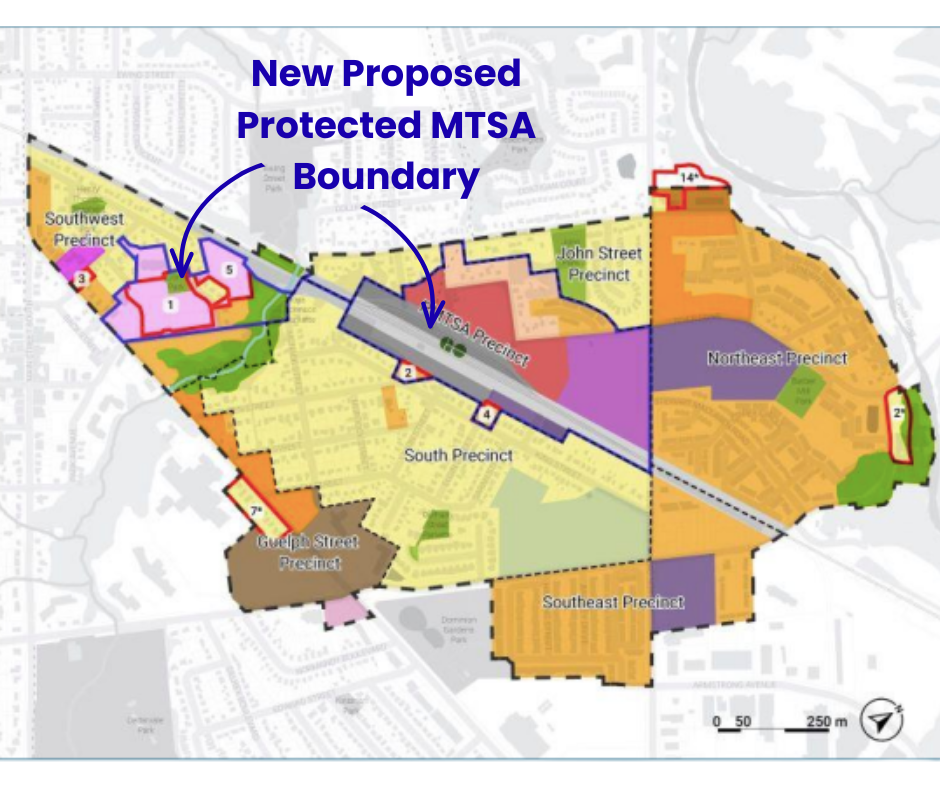Understanding the Proposed Protected MTSA
The Secondary Plan work around the Georgetown GO Station and Mill Street Corridor has reached an important moment, and I want to make sure residents have the information they need.
Council will be discussing the proposed MTSA boundary change and Protected Major Transit Station Area designation this Monday, November 17th, through agenda item 2i Report PD-2025-066 Georgetown GO Station Area/Mill Street Corridor Secondary Plan Review – Protected Major Transit Station Area Report.
If you would like to speak to Council about this, you can register as a delegate.
Delegation forms are due today by 4:00 p.m.
If speaking isn’t your thing, you can also share your thoughts by emailing your Councillors. Every perspective matters, and your input continues to shape how we plan for the future of this neighbourhood.
Why are we talking about MTSA boundaries?
In Ontario, areas around major transit stations, like the Georgetown GO Station, must plan for growth. In 2024, the Province set minimum density targets for these areas, measured in people and jobs per hectare through the Provincial Planning Statement (PPS 2024) (page 10).
For us, that target is 150 people and jobs per hectare unless the Minister permits something lower.
When Halton Region first drew the MTSA boundary in 2021, it included a very large area — essentially, the entire Secondary Plan. But instead of finalizing a density target at that time, the Town asked to pause until we could complete our own Secondary Plan review.
That work is now before Council.
Why the boundary is proposed to shift
Through many rounds of engagement, community members shared a consistent message:
We support growth where it makes sense, but we want to protect the character of established neighbourhoods.
Public input highlighted several priorities:
Preserve low-density residential neighbourhoods
Focus higher-density growth near the GO Station
Protect cultural and natural heritage
Maintain flexibility along Guelph Street
Align growth with infrastructure and community goals
Earlier this year, the Mayor established a Secondary Plan Advisory Committee to bring deeper community insight into this work. The committee included the Mayor, the Regional Councillor for Ward 3, both Ward 3 Town Councillors, and five resident members, supported by Town staff and our planning consultants. I was appointed Chair.
Over four meetings, the committee reviewed background materials, discussed heritage and neighbourhood priorities, examined MTSA boundary options, and provided direction that directly shaped the proposed smaller boundary and the recommendation to seek Protected MTSA status.
Town staff and the committee worked together to examine different MTSA boundary options. They landed on a revised, smaller MTSA focused on:
Areas already approved or proposed for medium or high density
Properties designated for redevelopment
Lands closest to the GO Station
In other words: the updated boundary reflects where intensification actually makes sense — and removes the stable neighbourhoods where it doesn’t.
This approach directly responds to what we heard from the community.
What does it mean to make it “Protected”?
A Protected Major Transit Station Area (PMTSA) is a special designation under the Planning Act. Once approved by the Minister:
It limits certain appeals (for example, appeals on heights, density, and permitted uses)
It provides stability for residents
It gives clarity for applicants
It supports good, transit-oriented planning
A protected designation also helps the Town meet the provincial requirements realistically. Because the boundary is focused on where growth can actually occur, the required density target is achievable without needing to ask for an exemption.
And importantly:
This proposal does not change any of the land use designations already endorsed by Council in principle.
It simply strengthens the way they’re implemented.
The power of community in shaping this direction
Throughout this process, residents have learned alongside each other, sharing questions, concerns, ideas, and lived experience. The Secondary Plan Advisory Committee in particular brought thoughtful, grounded insight that directly shaped the recommended boundary and policy directions.
This is what planning looks like when it’s relational, respectful, and rooted in community knowledge.
Why this matters for our future
A clearer, more focused MTSA boundary — combined with protected status — helps us:
Support growth where it fits
Protect neighbourhoods where it doesn’t
Honour cultural and natural heritage
Encourage a thoughtful mix of housing, services, and community uses
Build predictability into the planning process for everyone
This is about more than density targets. It’s about protecting what we value while planning intentionally for the future.
How you can participate
If you would like to share your thoughts, you have two options:
1. Speak at Council
Council will discuss the proposed PMTSA boundary on Monday, November 17th.
Delegation forms are due today by 4:00 p.m.
Link to report PD 2022-066
Link to November 17th Council Agenda
2. Email your Councillors
If delegating isn’t for you, you can send your comments, questions, or reflections directly to Council.
Your voice matters. And it is already shaping the direction we are taking together.


